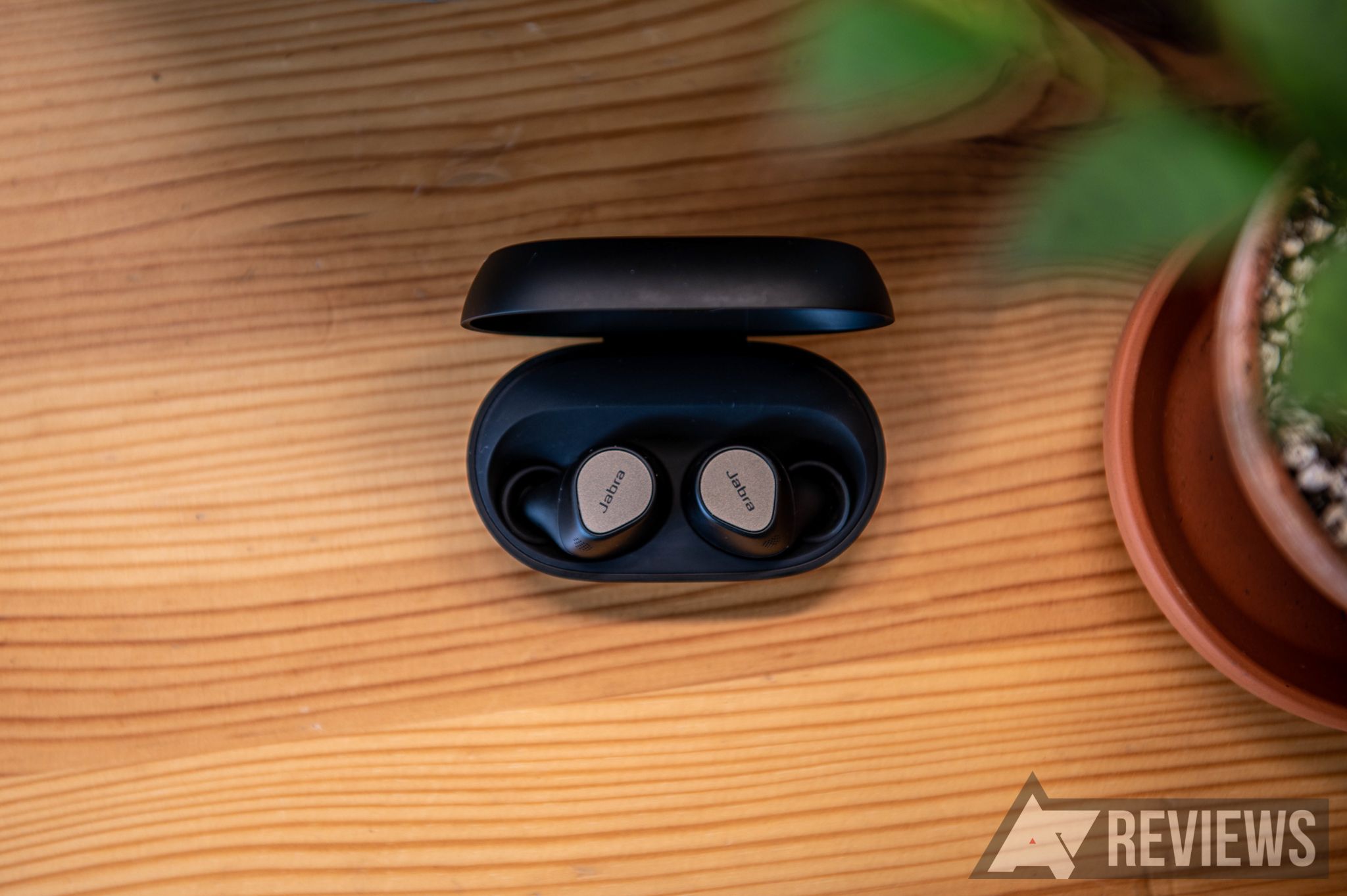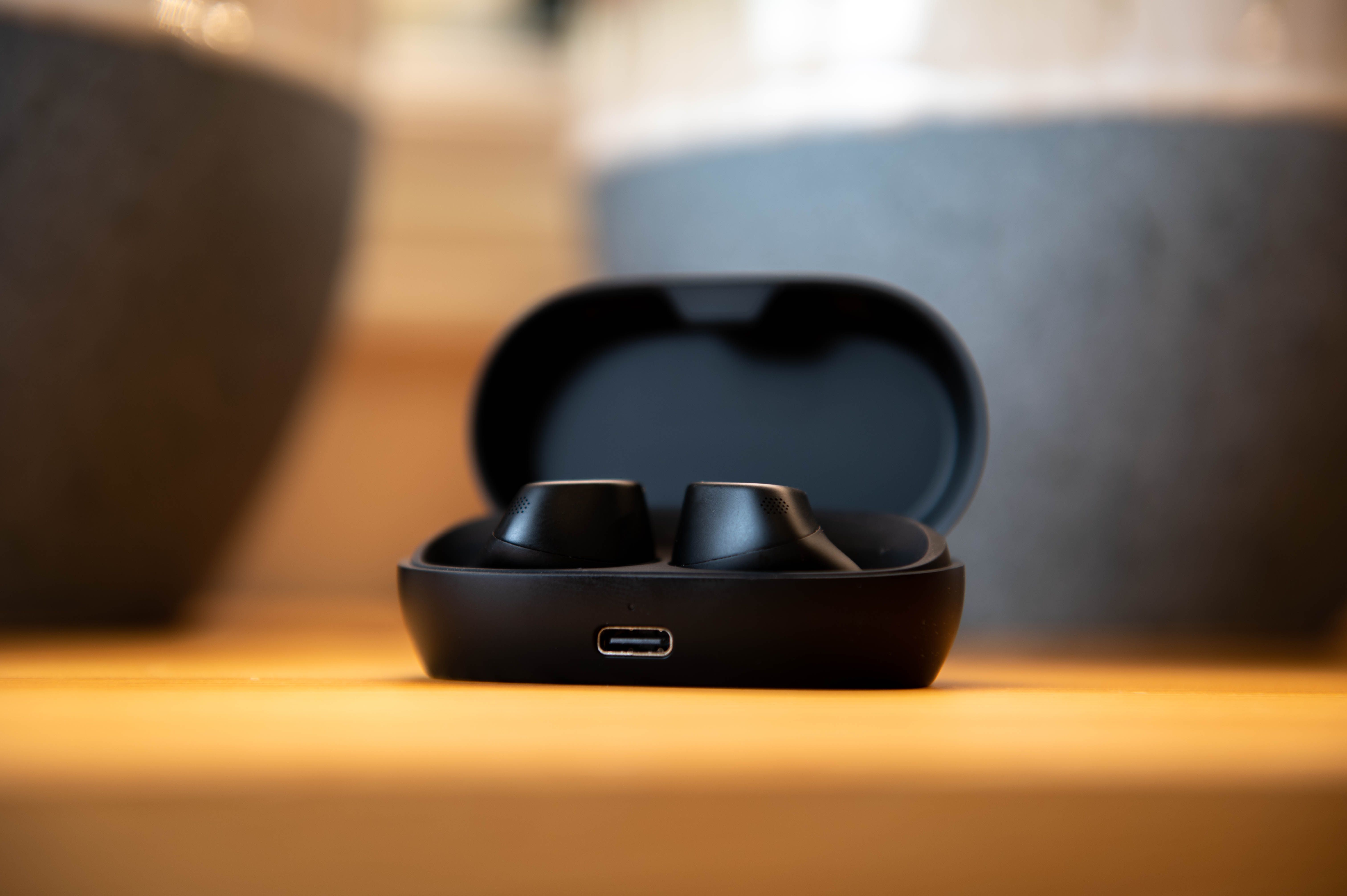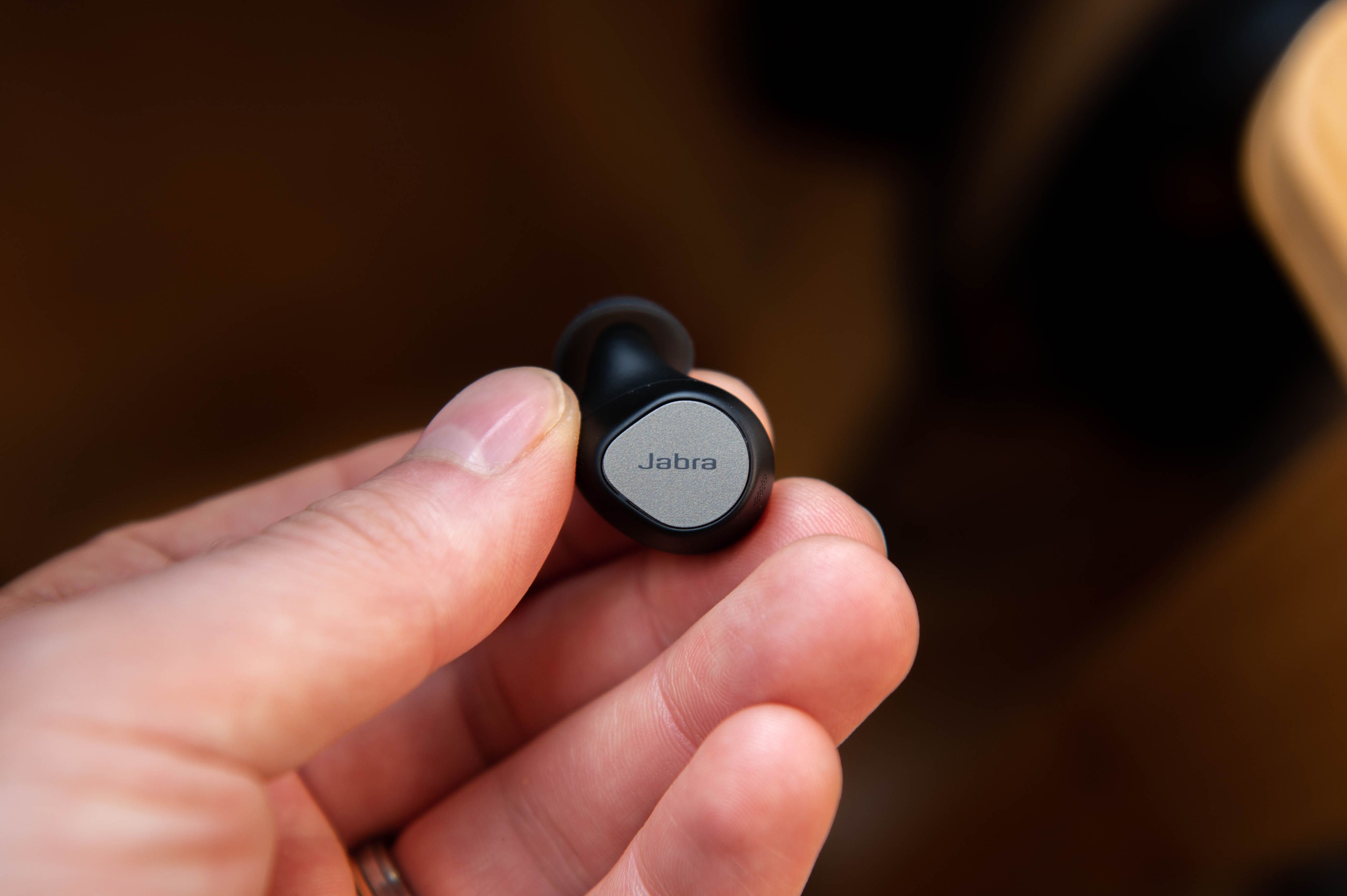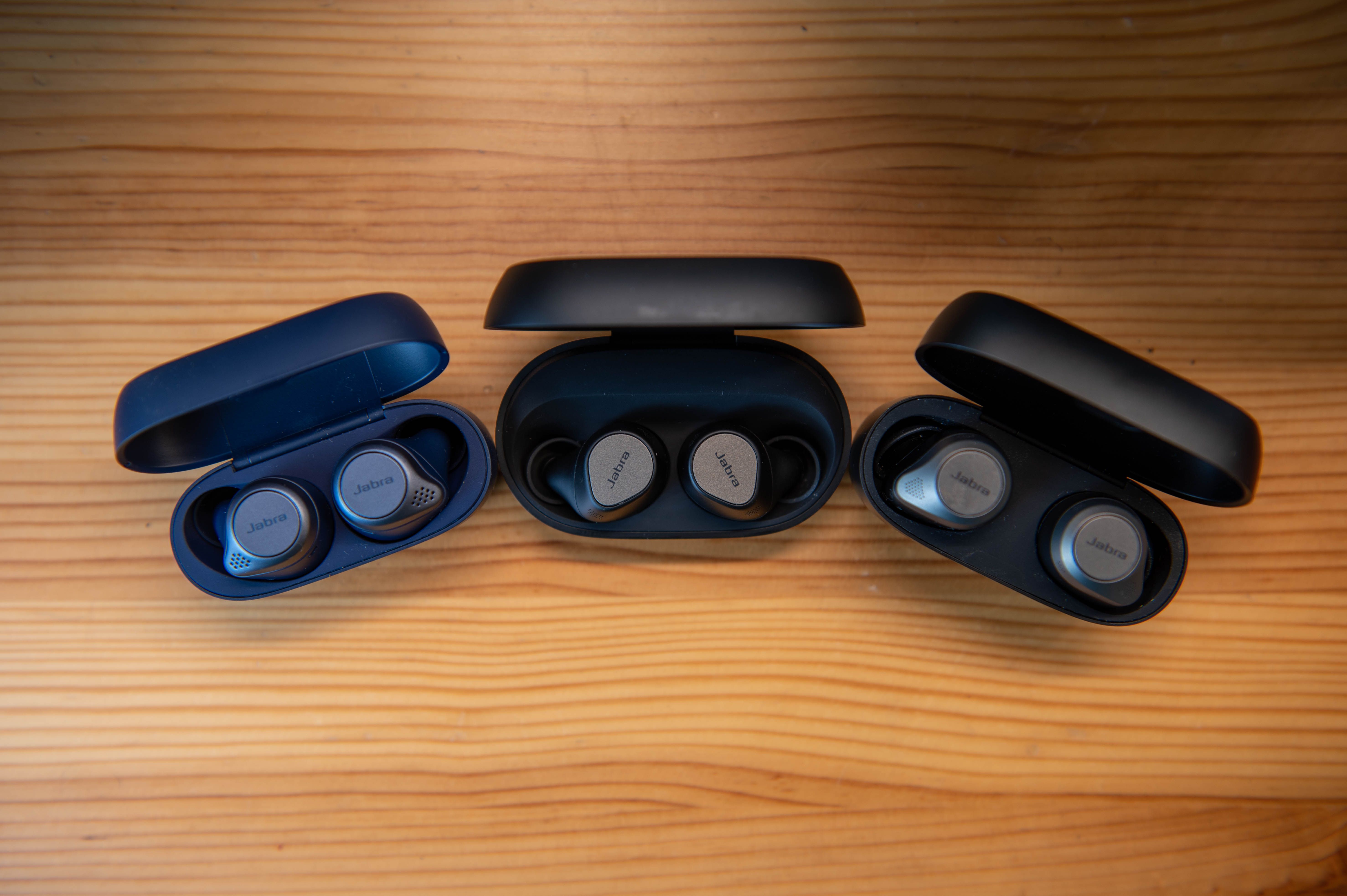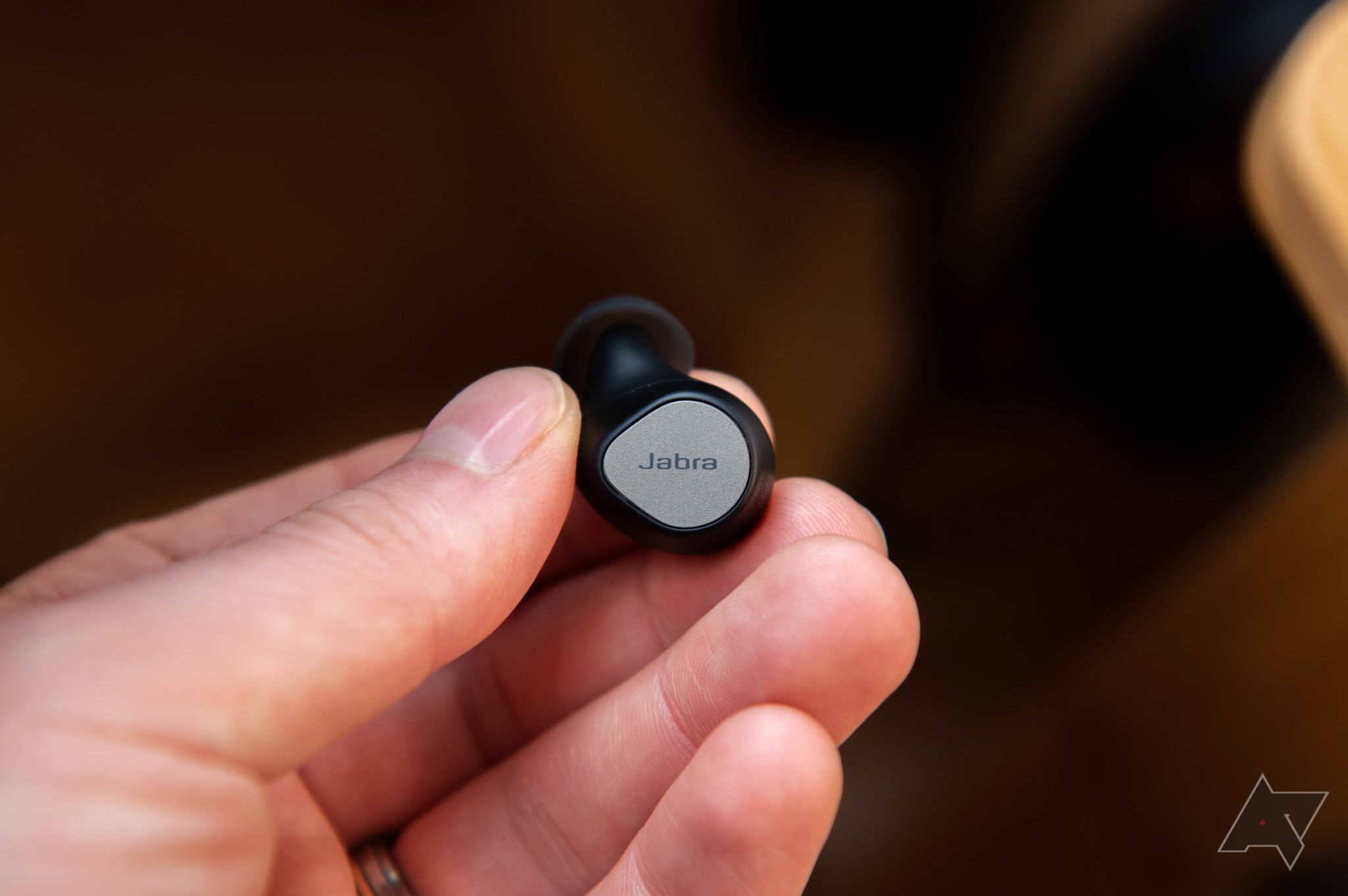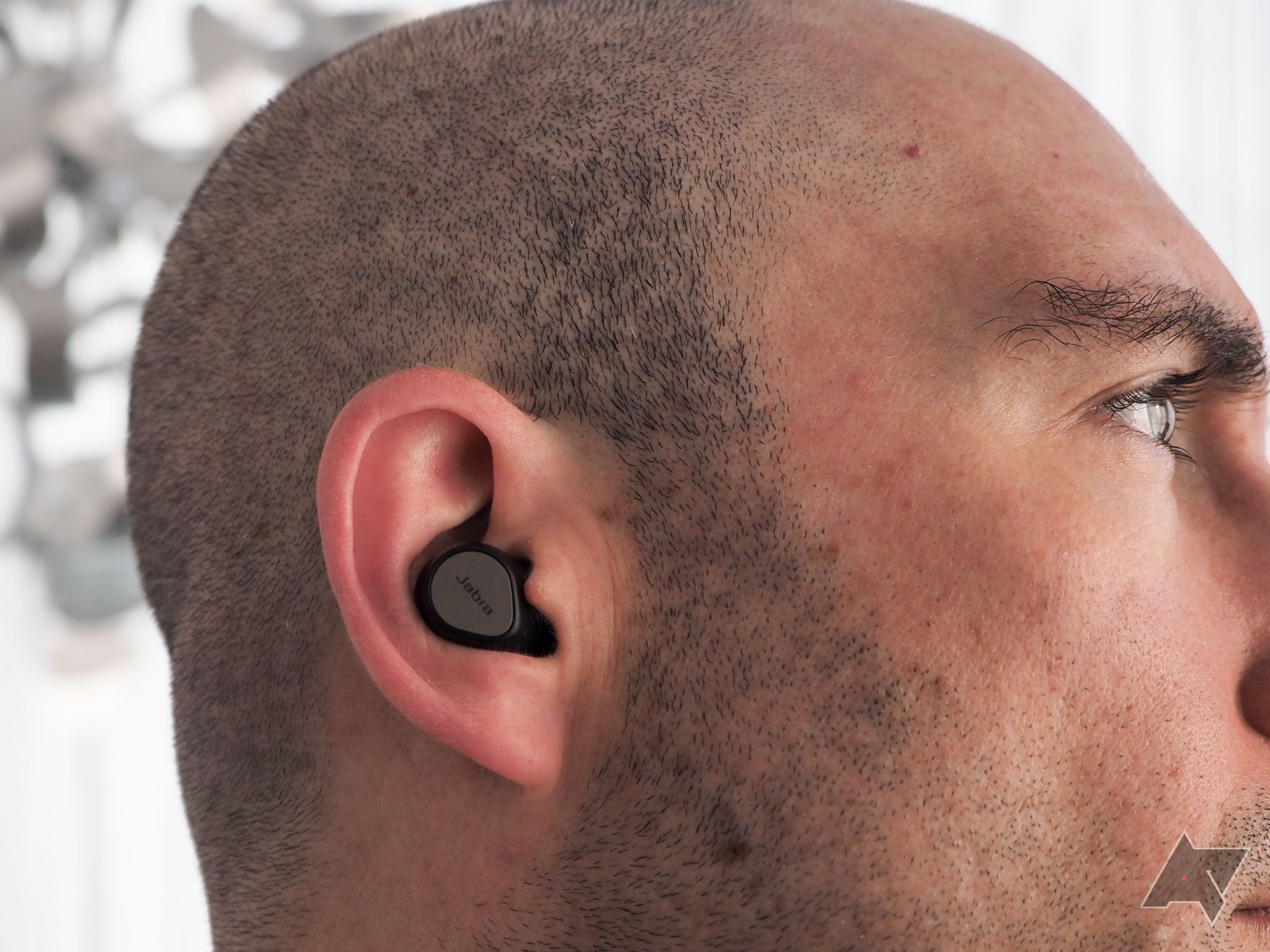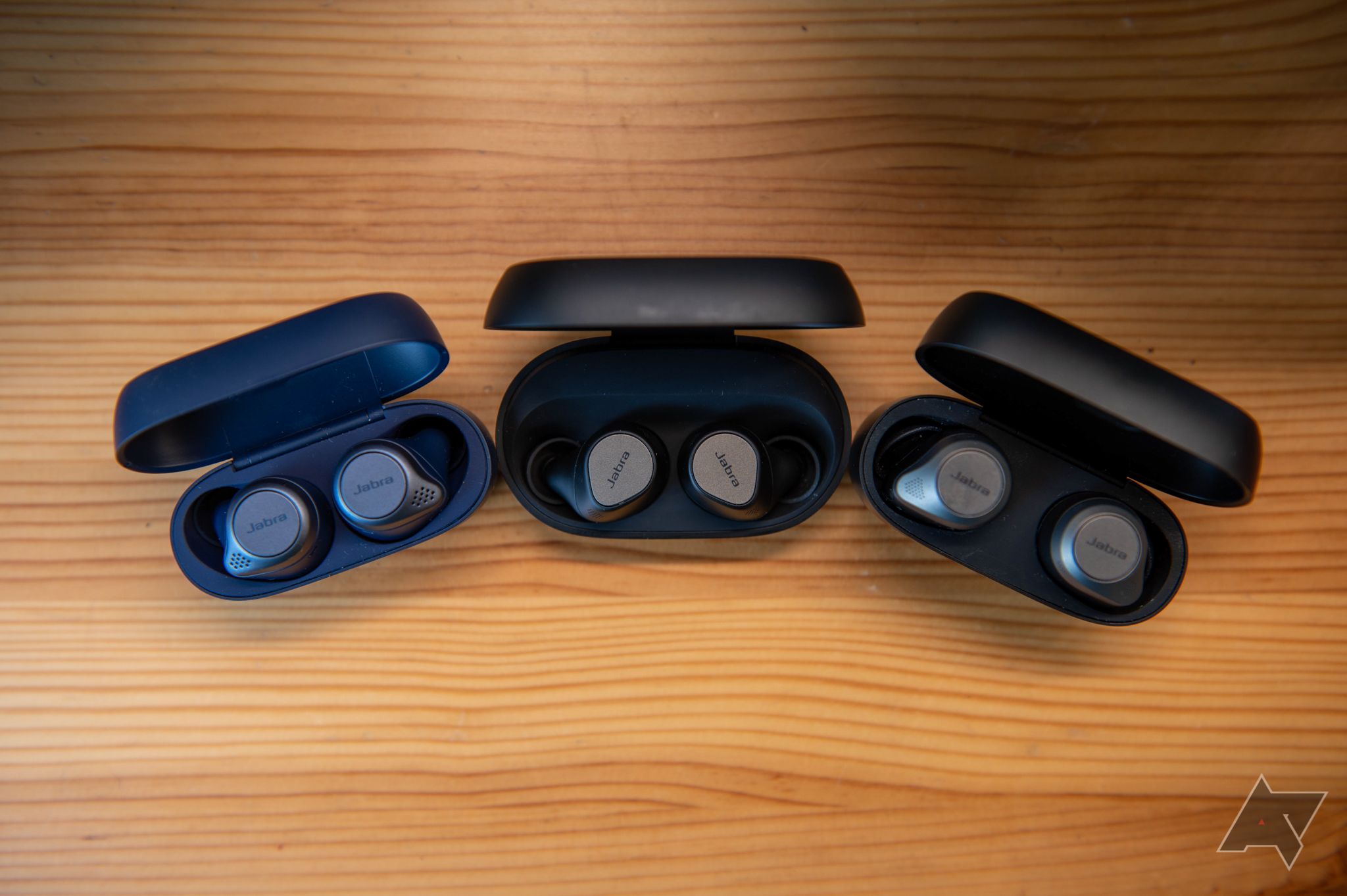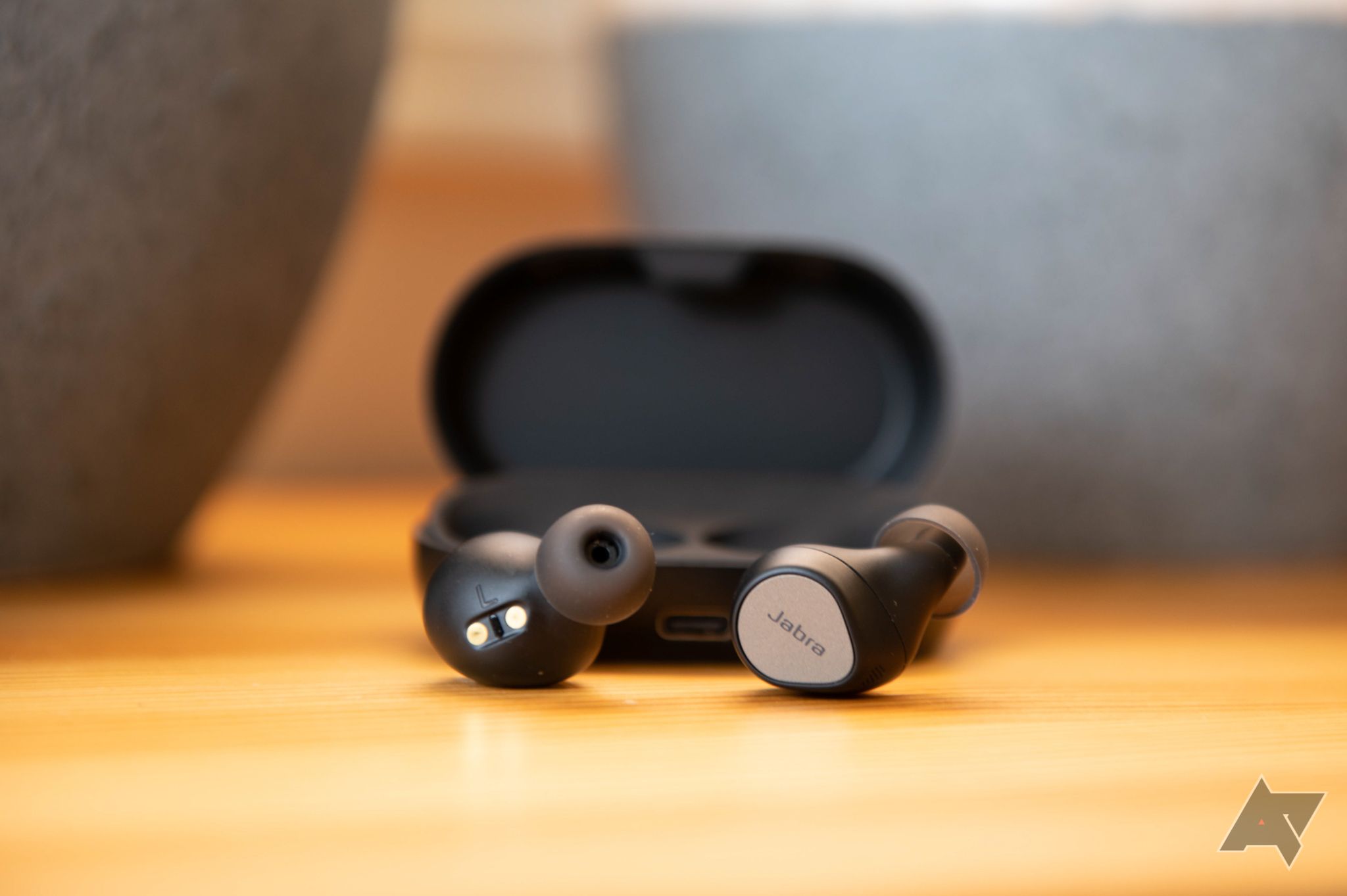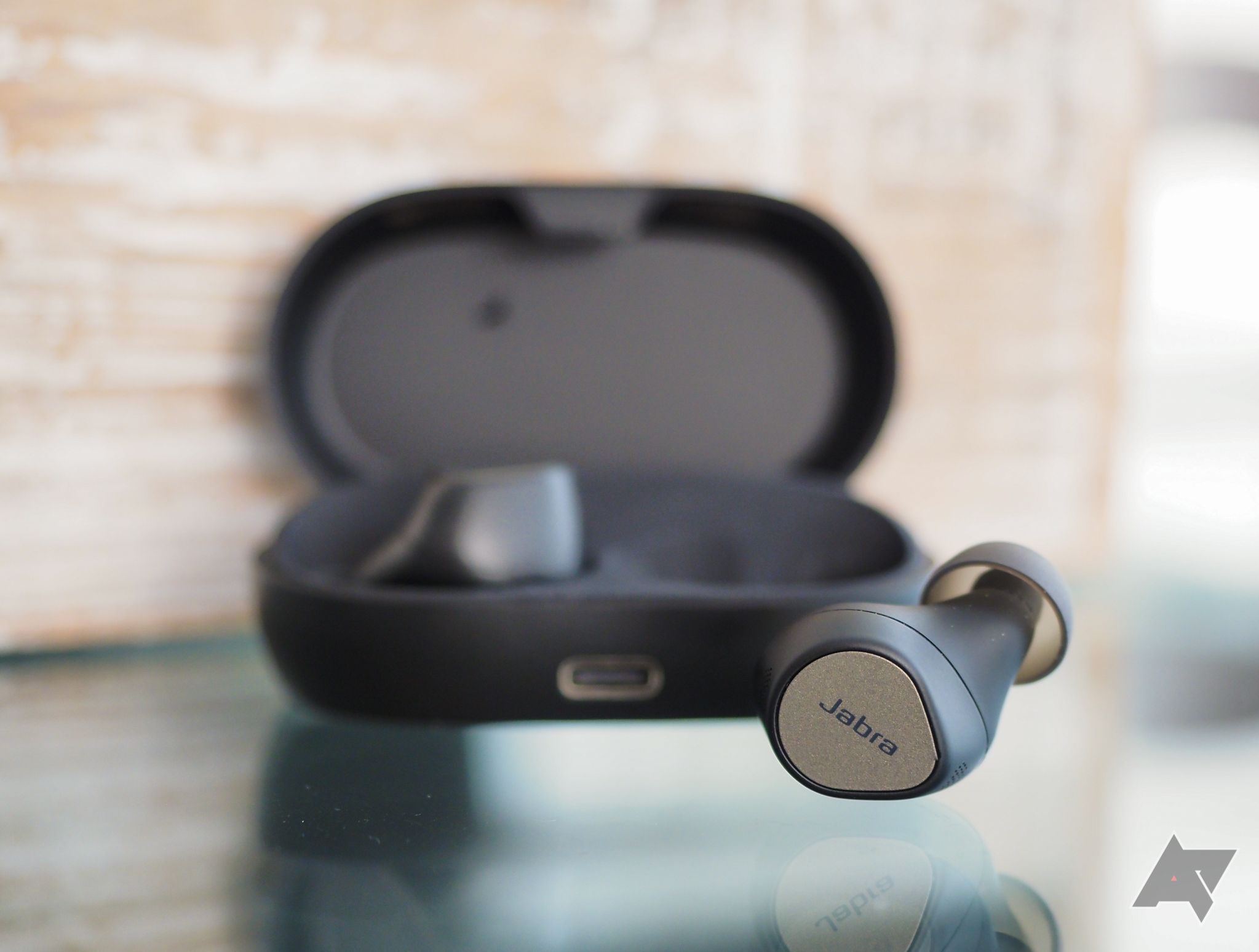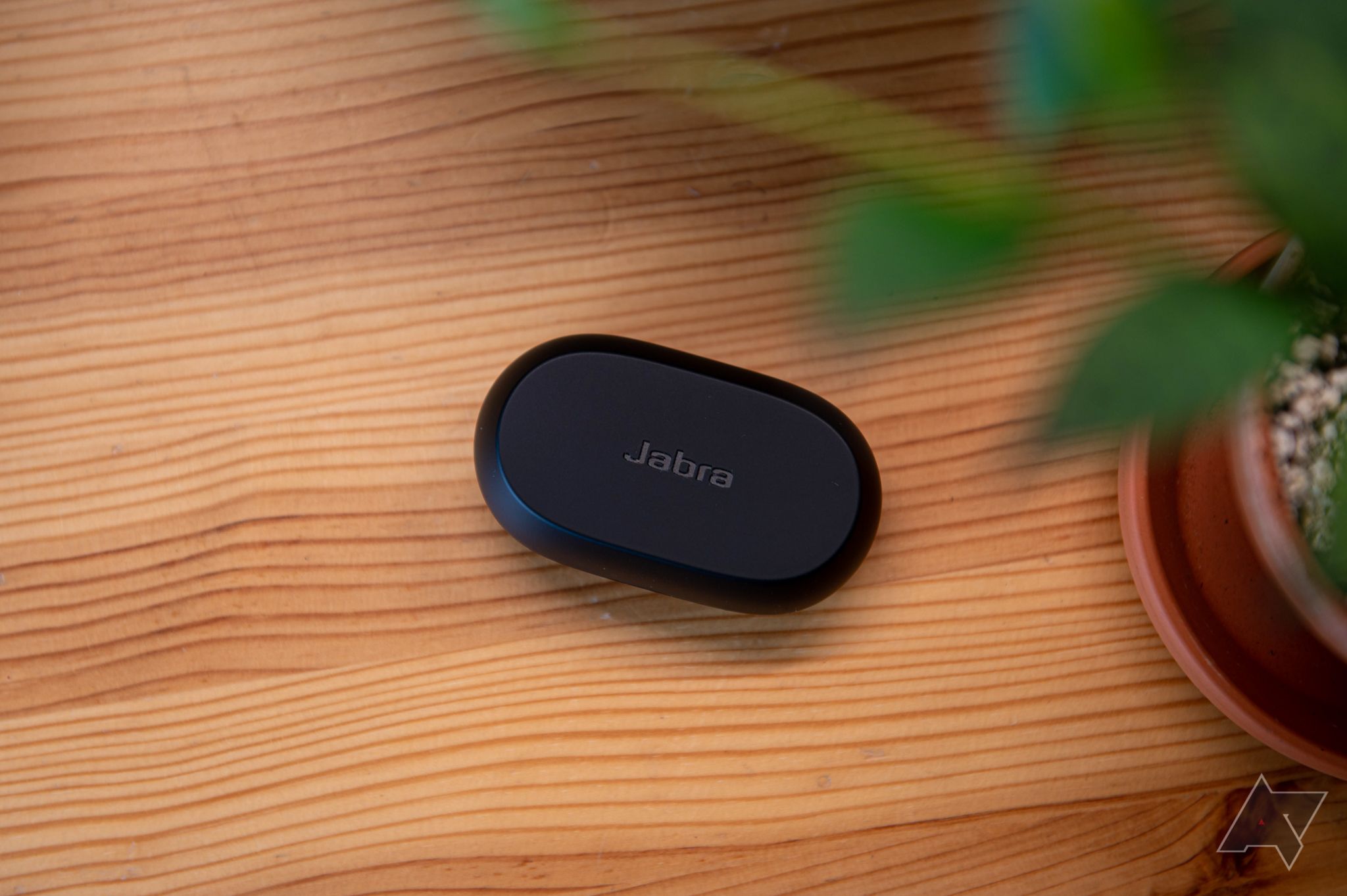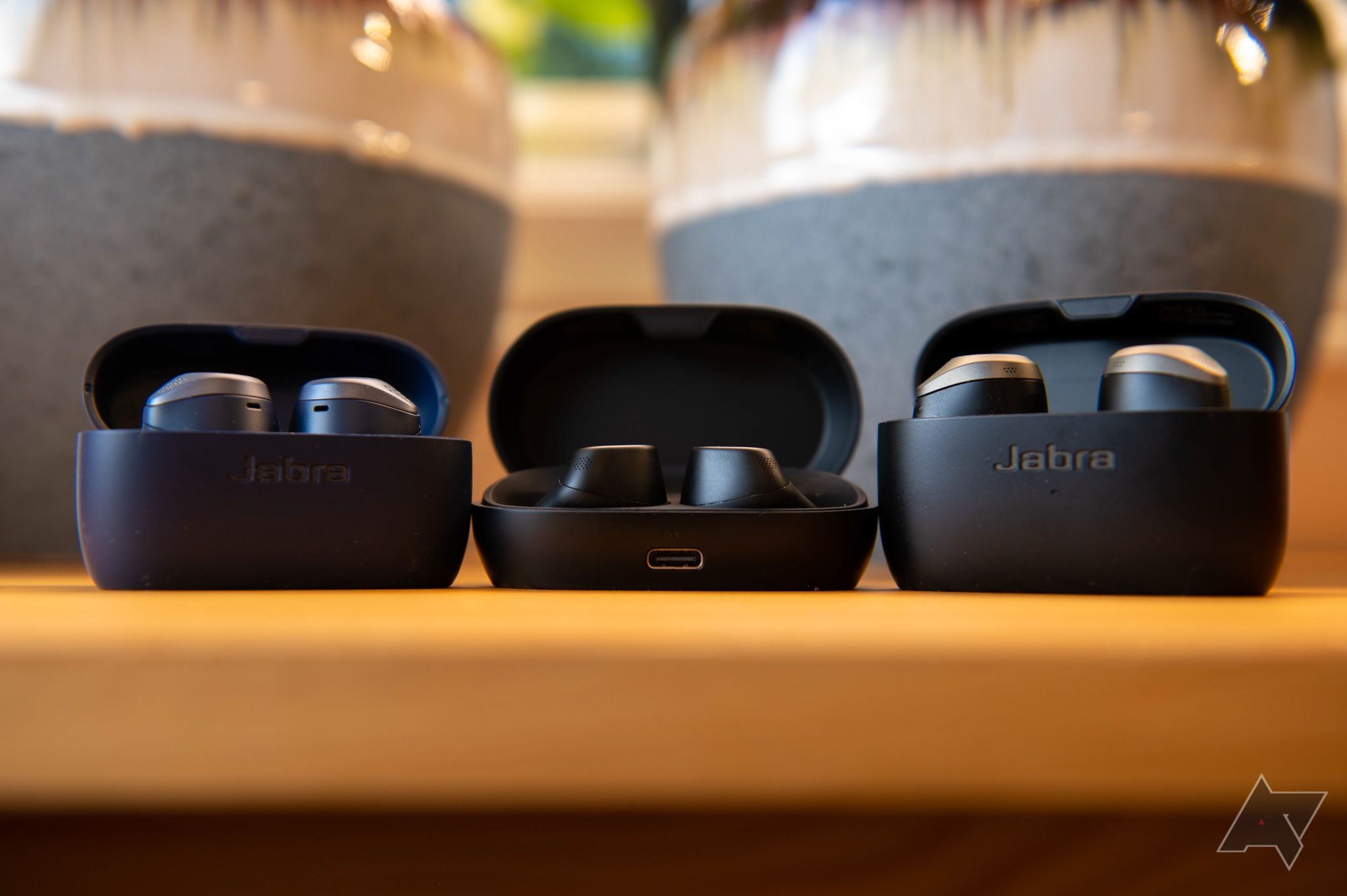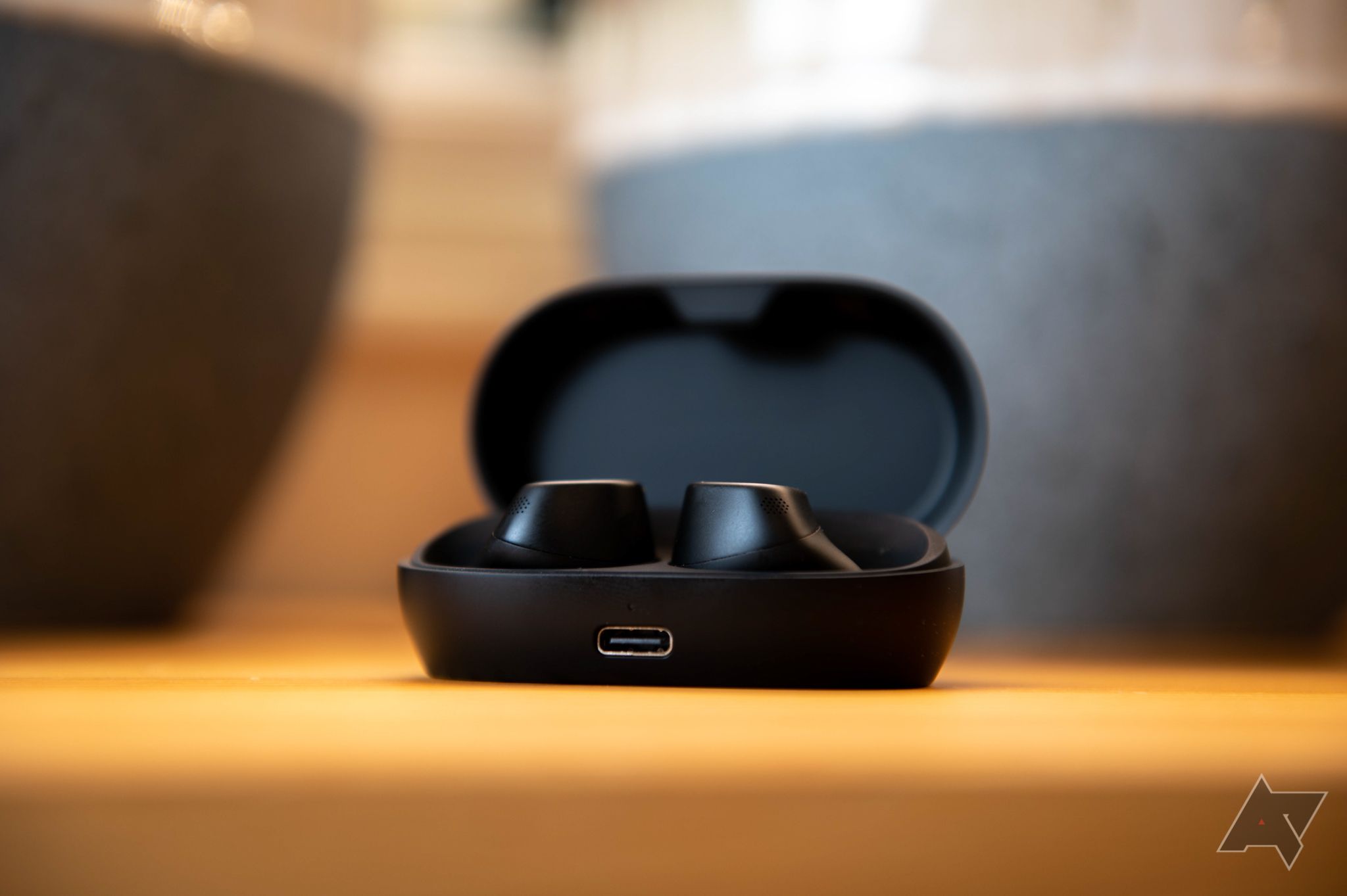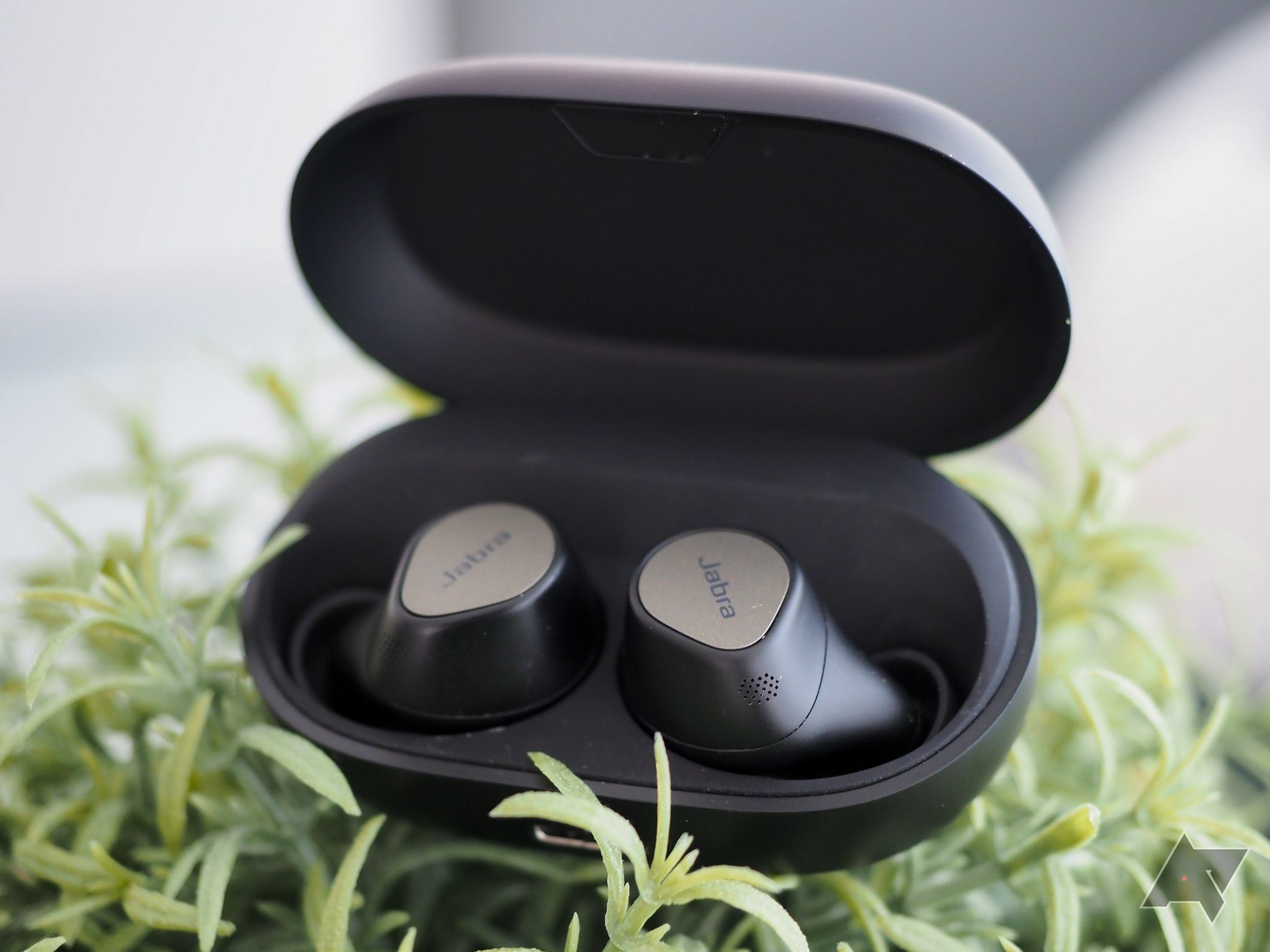When I think of true wireless earbuds, I think of Jabra. Not Apple, not Samsung — Jabra. While I'd used Apple's original AirPods when they first came out, it wasn't until 2018's Jabra Elite 65t that I understood the long-term implications of the form factor for not just convenience but comfort and sound quality. Chunky and a bit ungainly, the Elite 65t nonetheless became my first must-carry true wireless earbuds, replacing the neckbuds that I'd typically lugged around on planes, trains and other forms of transportation for many years.
Jabra followed up that pair with the superlative, and much smaller, Elite 75t, which featured longer battery life and a host of quality-of-life improvements gleaned from GN Audio's — that's Jabra's parent company — experience making hearing aids and B2B audio products. With the Elite 85t, which debuted in 2020, Jabra added ANC and doubled the size of the drivers, improving clarity at the expense of bass oomph, but their larger size and chunkier case brought some regressions for long-time fans of the series.
Now Jabra is back with the Elite 7 Pro, ostensibly bringing the best of all worlds for a reasonable starting price of $199. Smaller and lighter than the Elite 75t with the high-quality ANC of the 85t — not to mention upgrades to the microphones for clearer calls — the Elite 7 Pro gets a lot of things right, but some quirks lead me to question a few of Jabra's decisions.
Jabra Elite 7 Pro
The Jabra Elite 7 Pro are the company's latest top-of-the-line true wireless earbuds, smaller and lighter than the Elite 75t with better sound quality, battery life, and a massively improved set of microphones. But unless you make a lot of phone calls, at $200, you can find better options.
- Brand: Jabra
- Battery Life: 8 hours (30 with case)
- Noise Cancellation: Active
- Mono Listening: Yes
- Bluetooth : 5.3
- Microphones: 6, MEMS
- Connectivity: Bluetooth 5.2
- IP rating: IP57
- Supported codecs: SBC, AAC
- Weight (earbuds): 5.4g each
- Dimensions (earbuds): 19.1mm x 16mm x 17.6mm
- Material: ABS Plastic, metal, rubber
- Waterproof: Yes, IP67
- Charging: USB-C
- Driver size: 6mm
- Price: $200
- Spatial Audio: No
- Port: USB-C
- Dimensions (charging case): 40.3mm x 25.3mm x 69.6mm
- Excellent microphone quality for calls, even with tons of background noise
- Earbuds and small and mostly comfortable
- Superb battery life with ANC enabled
- Decent sound quality for the driver size
- Mono listening in either ear
- ANC is disappointing
- Redesigned ear tips make it harder than previous Jabra earbuds to achieve a good fit
- No multipoint at launch
- No Google Fast Pair support
Design, hardware, and what's in the box
One of the main selling points for the Elite 7 Pro is their size — while the slim, pillbox-shaped case exchanges Y-axis for X compared to the Elite 75t and is ultimately a little easier to pocket as a result, the earbuds themselves are some 20% smaller and a hair lighter, at 5.4 grams. Jabra says the overall design improvements should make the Elite 7 Pro more comfortable to wear for longer periods, but I found the redesigned silicone tips more finicky and ended up using the ones from the Elite 75t to improve my passive seal. More on that later.
The case moves the USB-C charger to the front, which offends me aesthetically but is otherwise a great move since most people end up opening a case to insert the earbuds right after taking it off the charger, so this eliminates a step. Jabra also stepped up its water ingress game this time around, bringing the Elite 7 Pro up to IP57 from the IP55 rating found on the Elite 75t; you had to spend $20 more to get the more water-resistant Elite Active 75t back 2019, but both have since been discontinued.
(Confusingly, Jabra is also releasing a cheaper Elite 7 Active which, instead of upping the water resistance, utilizes a "Liquid Silicone Rubber compound" to reduce the chance of the earbuds slipping and moving during intense workouts. I haven't used them yet so I can't comment, but I've worked out several times with the Elite 7 Pro and they hold up just fine.)
In the box you get a USB-C charger and three sets of silicone ear tips in small, medium, and large sizes. As I mentioned above, I had issues getting a proper seal on my left side with any of the tips and ended up poaching the large tip from the Elite 75t, which is a millimeter or two wider at the edges and provides (me at least) a better passive seal. Your mileage may vary, but just keep that in mind if you're coming from an older model.
Sound quality, features, and battery life
Jabra emphasizes a few things in the marketing material for the Elite 7 Pro: the quality of the microphones, which augment the two external mics with a bone conduction-based Voice Pickup Sensor to improve phone call clarity; and the improvements to ANC over previous generations.
I'll start with the microphones, since that seems to be the feature a lot of people care about: they're very good, among the best I've used in a pair of earbuds. I recorded two clips with three pairs of earbuds, one sitting at my computer desk in my office, door closed and no background noise, the other in the same room kneeling next to a fan on full blast. I did these tests with the Jabra Elite 7 Pro, the Jabra Elite 85t, and the Apple AirPods Pro.
The Elite 7 Pro won both tests by making the voice much more pronounced in the mix and by naturalizing the waveform so it didn't come across nearly as processed as the other two. There's a clarity and precision to the recording that I really like, and it's lacking from the other earbuds (and most of the competition for that matter).
In the test performed right next to a fan on full blast, the Elite 85t actually did a better job obfuscating the whirr of the blades so there's less background noise to distract, but the Elite 7 Pro still preserved the mid-range vocal frequencies more successfully. The AirPods Pro, while consummate in both tests, sounded more processed and distracting, respectively. Right out of the gate, if you're someone who spends a lot of their day on phone calls, buy what Jabra is selling when it comes to the Elite 7 Pro.
Jabra does this by utilizing the Voice Pickup Sensor whenever a specific threshold of background noise is met, transferring some of the onus from the microphones, which can easily be overwhelmed by errant frequencies, to the sensor scanning for vibrations in the jaw.
Unlike proper bone conduction headphones like Aftershoks' line of sci-fi-looking neckbuds, which rest on a user's cheekbone to transmit an audio signal using vibrations through the cochlea, the Elite 7 Pro's VPU never actually comes close enough to that part of the head to detect the precise movement of the jaw. However, it does come close enough that, combined with the existing audio signal from the microphones, is better able to isolate your voice than an earbud relying on microphones and noise-suppression algorithms alone. It's a neat trick, of which I was initially quite skeptical and now, after using it, quite impressed.
When it comes to other aspects of the Elite 7 Pro, it's important to note that Jabra is not positioning the earbuds as the company's true wireless flagship but as the successor to the beloved Elite 75t. That distinction is notable because the Elite 7 Pro, to retain its diminutive size, maintains the same 6mm drivers as the ones in its predecessor rather than the larger, more bass-heavy 12mm drivers found in the Elite 85t. You're probably not looking to buy these if music is your top, top priority, but it's worth mentioning anyway.
Even if you're not familiar with Jabra's typically bass-heavy signature sound, you'll probably be happy enough with the sound coming out of the Elite 7 Pro. Bass is present but not overwhelming or boomy, and there's a lovely balance to the entire profile that, unlike the default sound of the 85t, doesn't suppress the vocals with a mid-range dip. Cymbals crash and trail off without sibilance, but there is a brightness that you want to turn down with a bit of EQing. The main deficiency I noticed when compared to the Elite 85t was the 7 Pro's narrow, more compressed soundstage, something that's not unusual with smaller drivers. Maximum volume was also a bit lower with the 7 Pro than some other similar earbuds, but not enough to be concerning — on my Pixel 5, I comfortably listened two or three notches below the very top.
On Schoolboy Q's "Collard Greens," the deep churning thump of bass during the intro doesn't quite have the same impact as some larger wireless earbuds, though the artist's snake-like voice cuts through the beat smoothly. On Big Thief's "Masterpiece," the intro drums lack the force to compete with the droning guitars enveloping the vocals that, paired with a narrow soundstage, let the song down. Nothing played through the Elite 7 Pro sounds bad exactly, but very little impressed me, either.
Of course, Jabra makes a big deal about the quality of its ANC and how much it's improved over previous versions. While it certainly occludes more background noise than the tacked-on noise cancelation of the Elite 75t, which didn't ship with the feature and had it added in a software update a year or so after its initial release, it doesn't quite compare to the Elite 85t, the AirPods Pro, or the Samsung Galaxy Buds Pro. Even at its maximum setting — the ANC is adjustable through Jabra's Sound+ app — I wasn't impressed with the level of background fan, car, or airplane engine noise suppressed.
In fact, it's among the least effective active noise canceling systems I've used in a wireless earbud in the past couple of years, especially at this price range. The one bright spot is that, with a good seal, the earbuds reduce a fair amount of background noise passively, but that is no excuse — especially because the Elite 85t already do a better job with older tech.
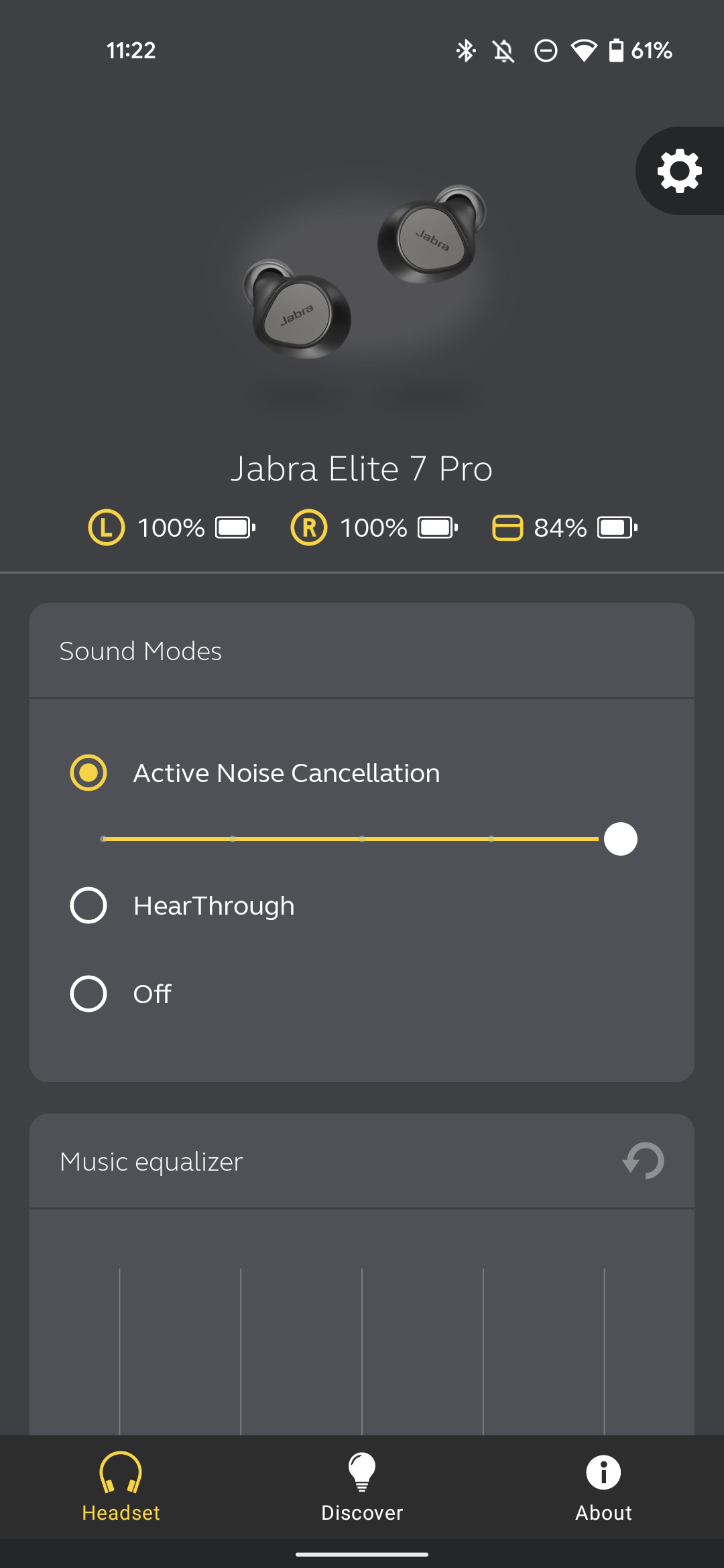
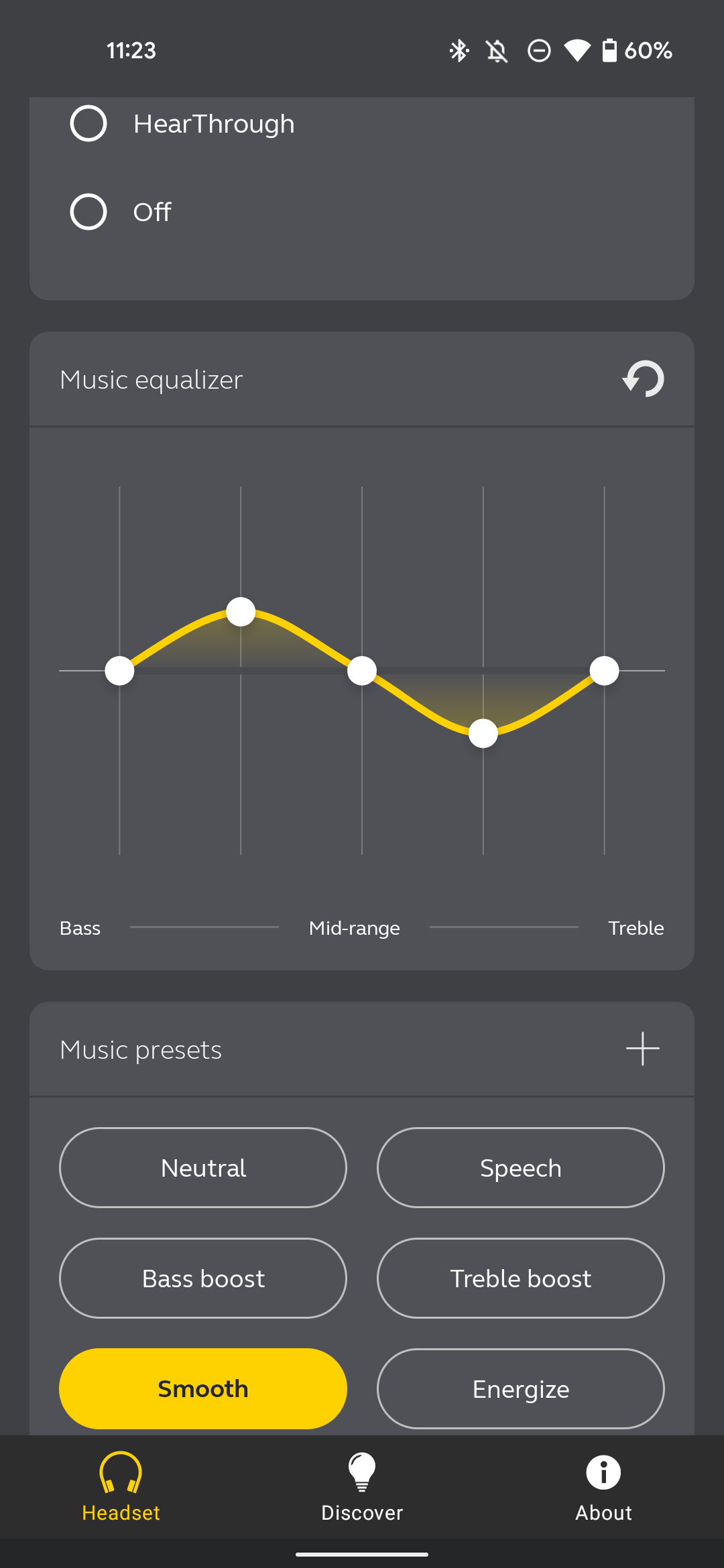
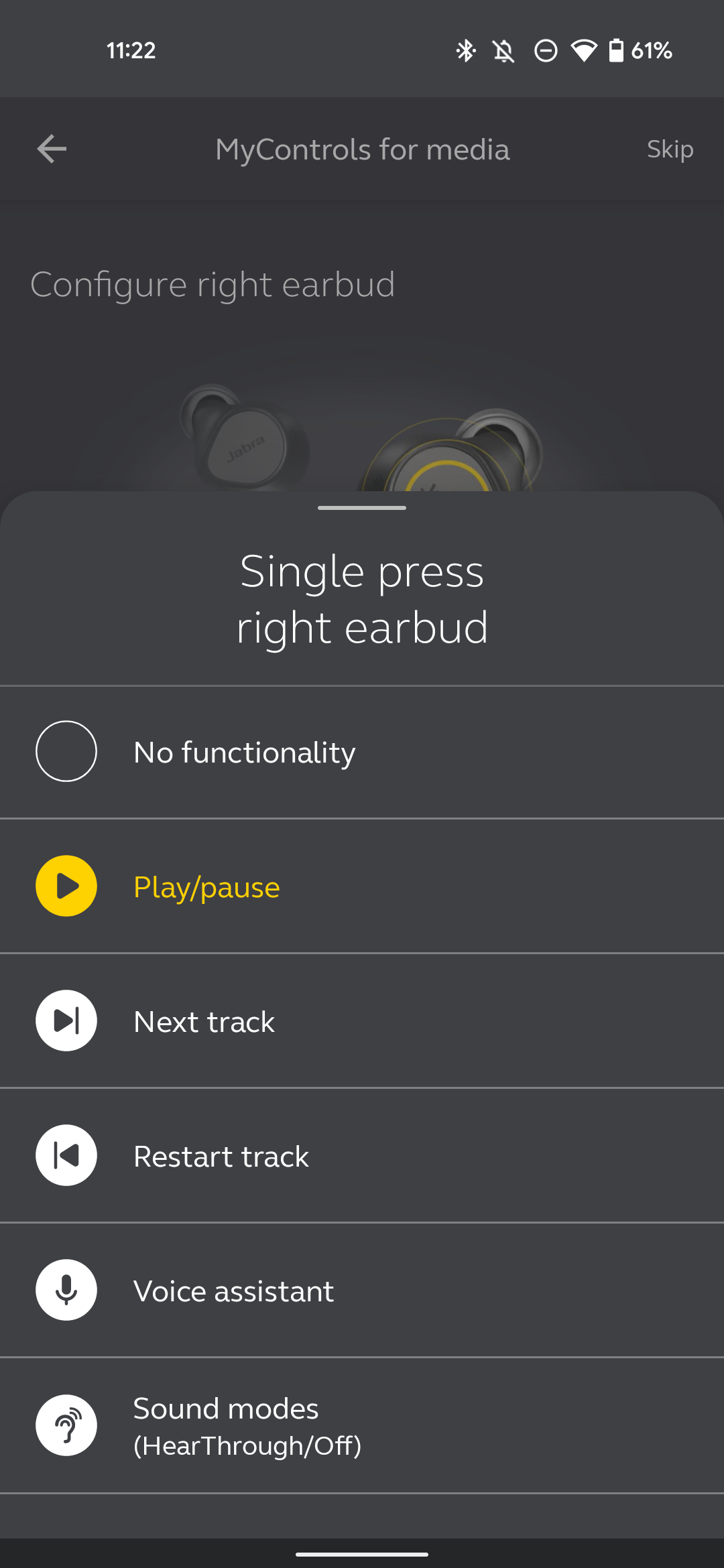
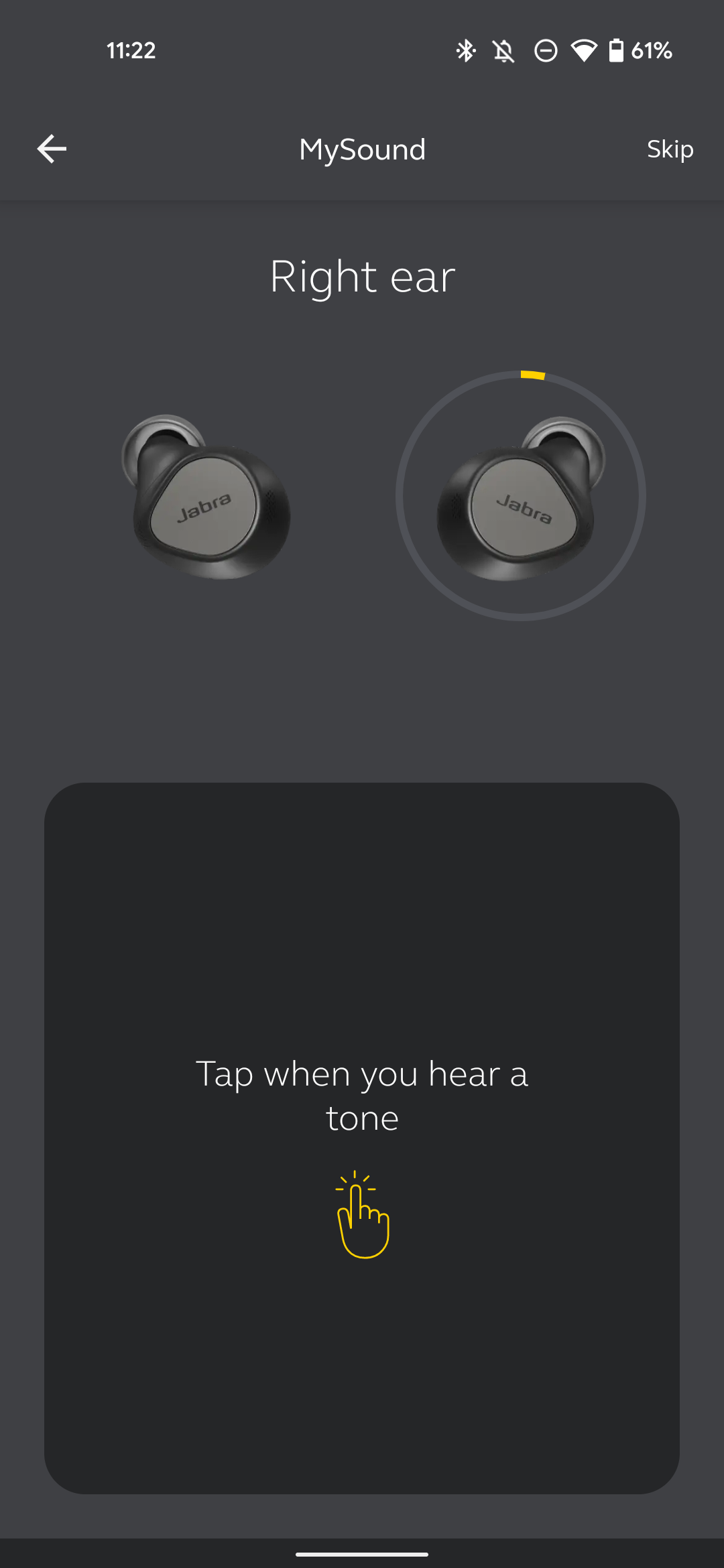
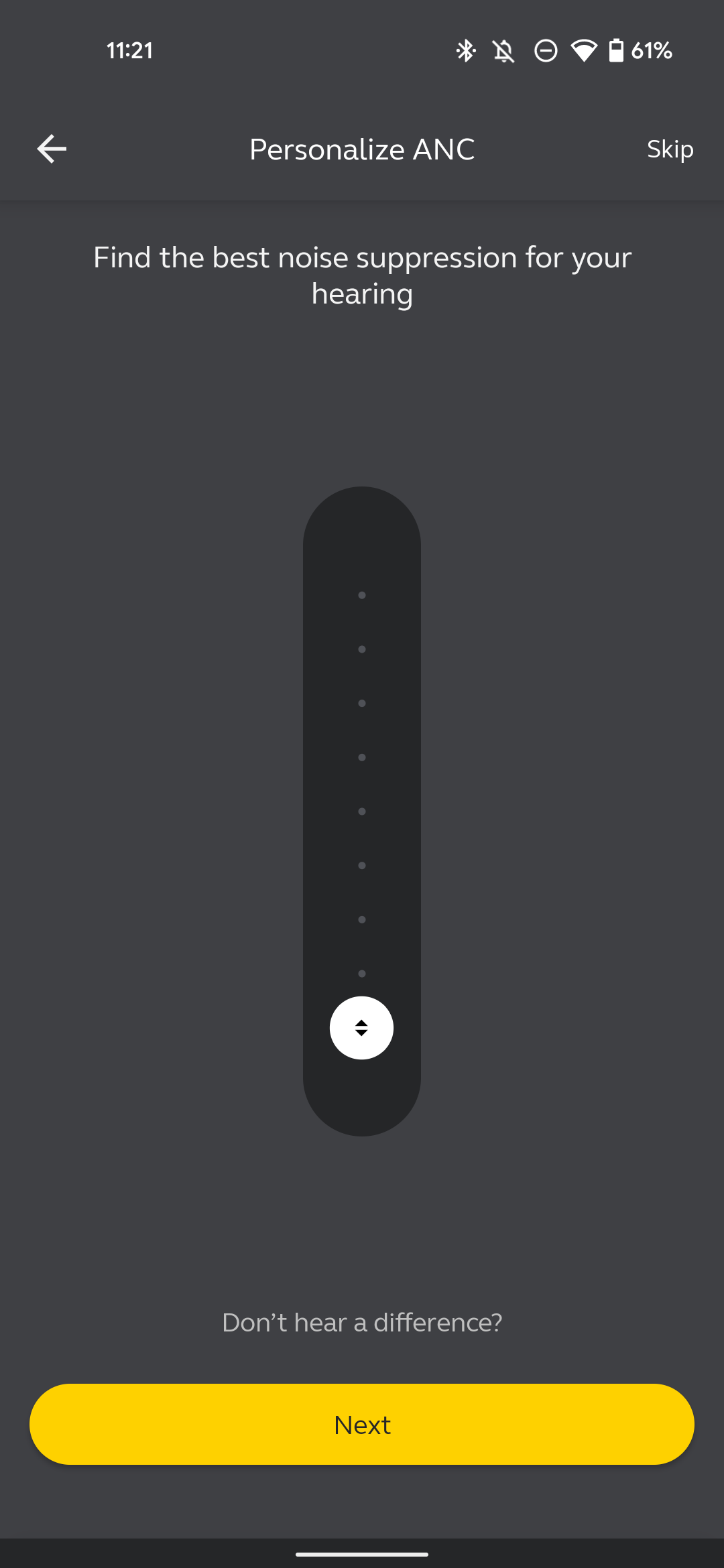
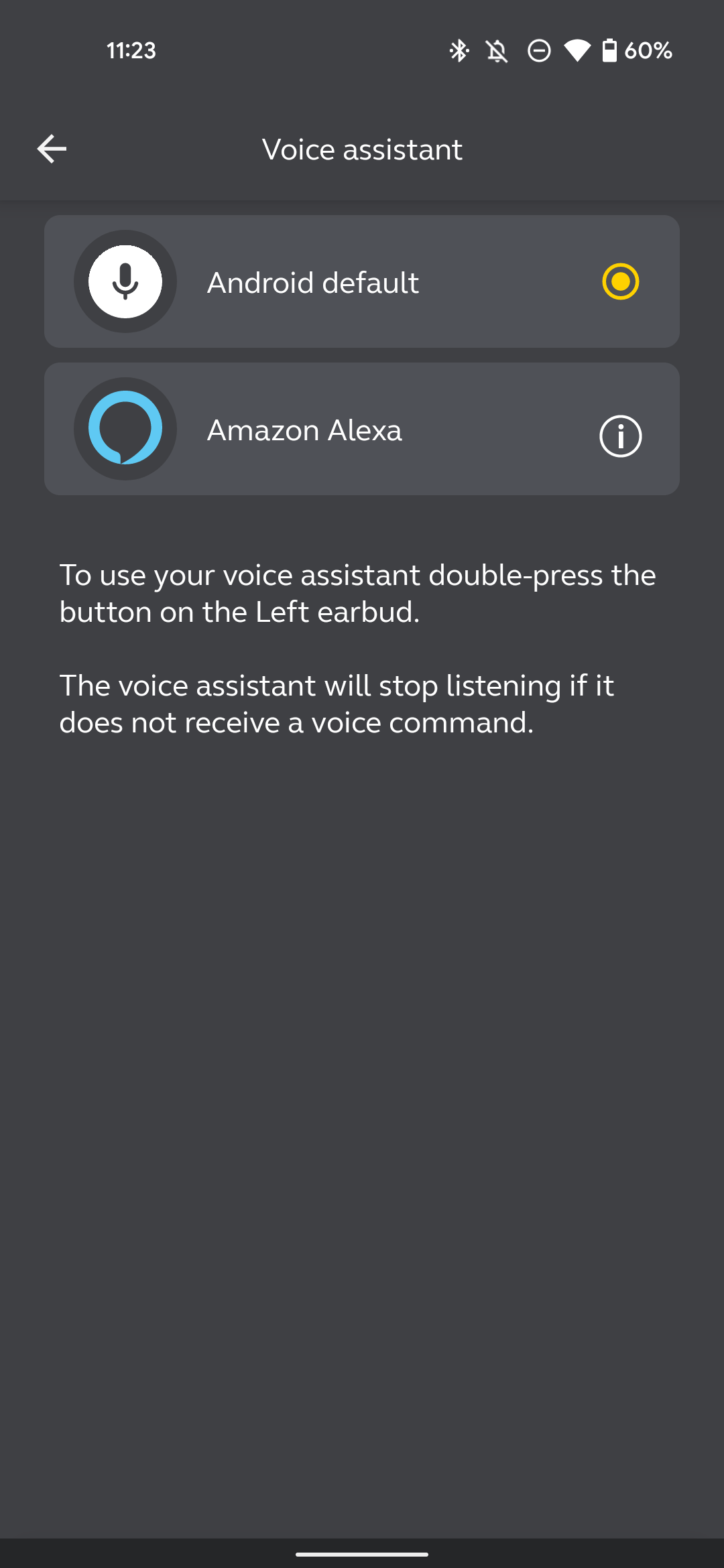
You'll spend a decent amount of time in the Sound+ app, too, which has recently been adorned with a growing set of features for this newest generation of earbuds. Jabra now supports a fit test, similar to Samsung, that checks for a proper seal and, without one, recommends a different set of ear tips.
There's MySound, which performs a short hearing test to build a personalized equalization for each ear and does a pretty good job at adjusting for minor hearing loss (my right is slightly more impaired than my left). MyControls adjusts what the physical button on each earbud does, which is important since the Elite 7 Pro are the first in the company's premium earbud line to support mono listening in either ear — the Elite 65t through 85t only let you mono with the right ear, a huge point of contention with the (extremely-vocal-on-Reddit) Jabra community.
Finally — and not to end the feature parade on a sour tone — the Elite 7 Pro have a pretty severe regression from the Elite 75t and 85t in one important way: multipoint support. Jabra initially told reviewers like me that the Elite 7 Pro would support being connected to two devices at once, but now the promise is that it will come in a future update. Indeed, it's even difficult to pull a connection from one device to the other; to get the earbuds to connect to my MacBook Pro I had to physically disconnect them from my Pixel 5. Not great. Also not great is the fact that the Elite 7 Pro doesn't support Google's Fast Pair standard, which would make reconnecting to an existing phone much easier.
Finally finally, on the subject of battery life, at least here I can end on a high note: these are great. More than eight hours of uptime with ANC on — I got between close to nine hours in my testing, with an extra hour tacked on with noise-canceling disabled — which is among the best I've achieved on any true wireless earbuds in some time.
Should you buy them?
Yes, especially if you use your earbuds to make a lot of phone calls. While I like most things about the Elite 7 Pro, the real clincher here is the microphone quality which, paired with some incredible battery life and stellar in-ear comfort, make them the best I've used for that purpose.
If your primary concern is sound quality, there are better options out there at the same $200 price, from Samsung's Galaxy Buds Pro to Sennheiser's now-discounted Momentum True Wireless 2. If you're looking for dedicated workout buds, either wait for the Elite 7 Active, which should offer a more solid fit while running and working out, or the Jaybird Vista 2, which also use physical buttons but are a bit more robust than these.
Still, Jabra's done something pretty impressive here; aside from the lack of multipoint at launch and the mediocre ANC quality, there isn't a ton to dislike. Aside from phone calls, it doesn't do anything best-in-class, but the Elite 7 Pro are a solid choice that will happily slip into a pocket for a couple of years.
Buy these if...
- You make a lot of calls
- Size matters
- You like physical buttons on your earbuds
- Battery life matters more than sound quality
Don't buy these if...
- You need to block out the world
- You want to connect to multiple devices at once

